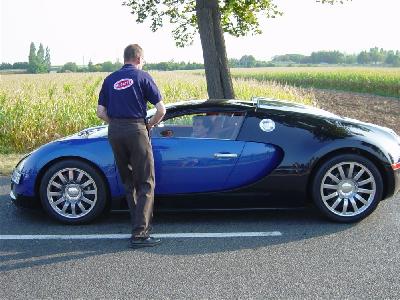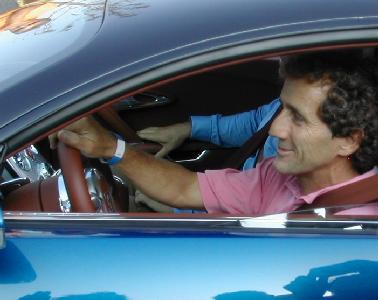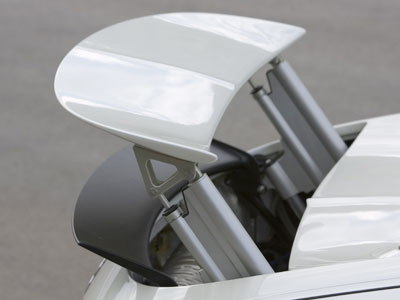
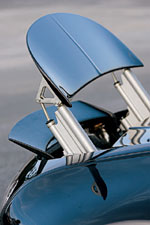
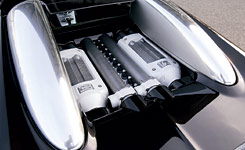
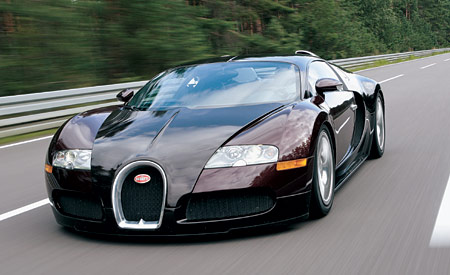

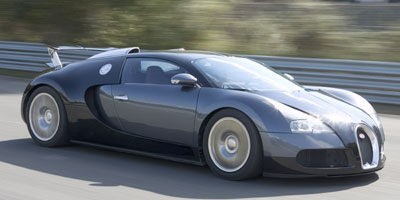
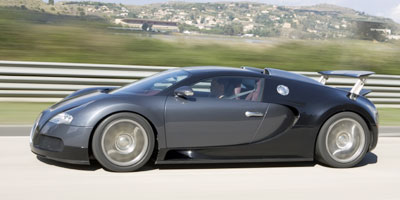
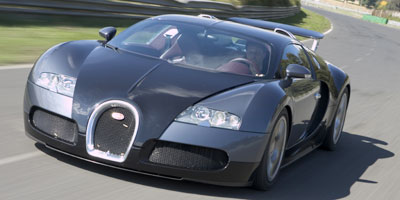
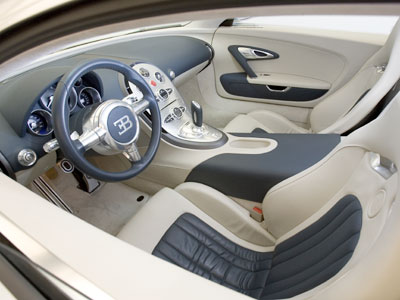
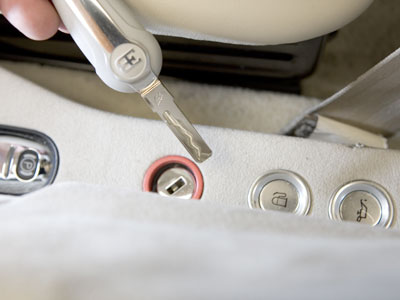
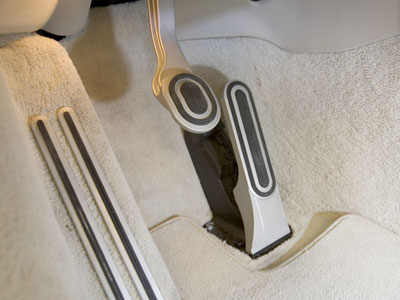
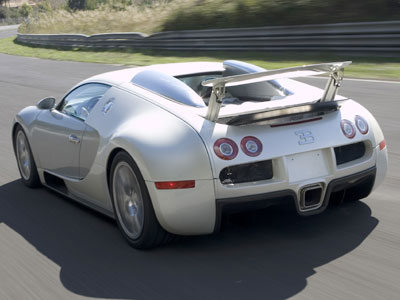
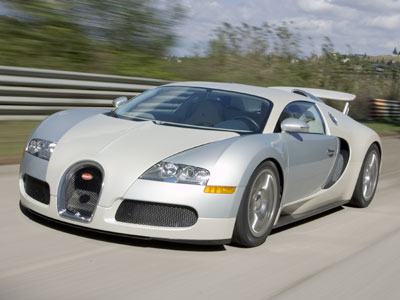
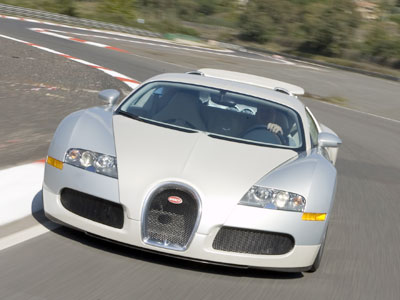
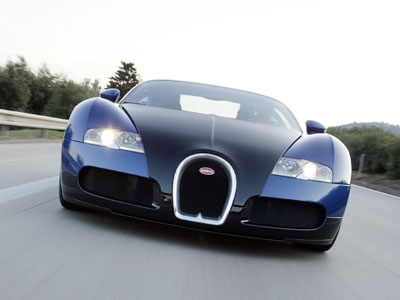
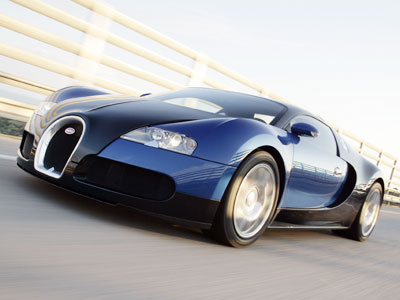
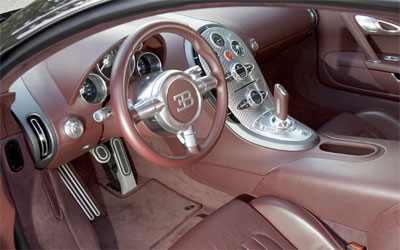
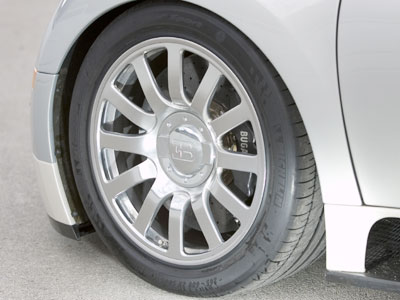
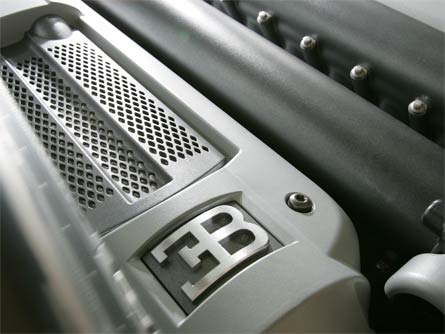

When you're ripping along at 253 mph, your mind is not drifting aimlessly. Your senses are cranked up to full volume to detect any hint of impending catastrophe in the maelstrom of wind rush, tire thrum, mechanical thrash, and exhaust roar that surrounds you.
Is that slight shift in the whistling wind caused by a body panel coming loose? Does that vague vibration signal a tire starting to delaminate? Does that subtle new mechanical whine presage a failing bearing that's about to lock up the powertrain?
No such problem developed on the Bugatti Veyron 16.4, because it is not a half-baked aftermarket or boutique road burner. It is a production car developed and tested to the standards of Volkswagen, Bugatti's parent company. With a top speed of 253 mph, it is also the fastest production car ever built.
Production, of course, is a relative term. In the case of the Veyron, Bugatti plans to build only about 50 cars a year at a price of 1 million, which is about $1,250,000 as this is written. To this rarefied market Bugatti has brought an unusual level of sophistication and engineering necessitated by the promise of 1001 metric horsepower (or 987 American horses) and a top speed of 252 mph, a pledge from former VW boss Ferdinand Piëch when he unveiled the production-intent Veyron at the 2001 Geneva auto show.
Achieving 1000 horsepower in a racing engine is one thing, but to do so in a reliable, refined, durable, and emissions-legal configuration is much harder. The energizer in the Veyron is a WR16 displacing 7998cc and turbocharged with 15.8 psi of boost. You can think of it as two Passat WR8 engines put together and pumped up by four turbos.
But the Bugatti engine has more cylinders, more displacement, more power per liter, and more output overall than any other engine in the WR family tree. When I ask Bugatti development boss Wolfgang Schreiber to explain how the same engine can be rated at 1001 SAE net horsepower at 6000 rpm for the U.S. but only 987 horsepower (1001 PS) for Europe, he laughs, saying, "The production engines are all putting out between 1020 and 1040 PS, enough to cover both promises."
The engine's torque peak is equally mighty at 922 pound-feet, developed between 2200 and 5500 rpm. The four small turbos minimize throttle lag, and the 9.3:1 compression ratio ensures reasonable torque even before boost develops.
All that twist required a dedicated transmission. The Veyron gets a King Kong seven-speed version of VW's twin-clutch gearbox, called DSG. Like the DSG available in the Audi TT, it operates with an automatic mode or a full manual mode via paddle shifters. Because gearchanges occur with one clutch disengaging as the other engages, shifts are uniformly smooth and swift.
With about as much engine output as two Corvette Z06 V-8s, it's no surprise that Bugatti engineers decided to go with all-wheel drive. We don't have many details about the driveline, but the front-to-rear torque split is automatically adjusted to suit dynamic conditions and can range from 100 to 0 percent at either end.
An engine, particularly a turbocharged one, that develops four-digit power throws off more heat than a dozen pizza ovens. Consequently, in the nose of the Veyron are three coolant radiators, one heat exchanger for the twin air-to-liquid intercoolers, and two air-conditioning condensers. There are also transmission and differential oil coolers on the right side and a large engine-oil cooler in the left-side air intake. To help heat escape from the engine compartment, the big WR16 sits in the open, enclosed by no cover of any kind. This powertrain propels the 4300-pound Veyron as effortlessly and gracefully as Tiger Woods belts a 300-yard drive.
My experience with the car took place at Ehra-Lessien in Germany, Volkswagen's test track and high-speed theme park not far from VW headquarters in Wolfsburg. At least it will soon become a theme park because Bugatti plans to let Veyron owners bring their cars to this 13.0-mile circuit to explore the top speed of their cars. In addition to finding out how fast the Veyron can go, I was a guinea pig for this ultimate high-speed thrill ride.
We started with two familiarization laps to get a feel for the track and the car. The track is simple, with a pair of high-banked, 150-mph corners connected by two five-mile-long straights,one of which has a slight bend so that it touches a common parking area.
With the Veyron's high beltline, I couldn't see any of the front bodywork from the driver's seat, but the view of the pavement immediately in front of the car is excellent. The driving position is comfortable, with a snug sport seat that provides great lateral support and manual fore-and-aft and seatback-angle adjustments (a plusher power seat will be optional).
Even after it was lowered to my preferred position, the steering wheel did not obstruct my view of the instrument cluster. And despite the Veyron's low, 47.5-inch height, there was plenty of clearance between my helmeted head and the headliner. Schreiber promises the car will accommodate drivers as tall as six foot seven.
Although the Veyron idles with a quiet murmur, as soon as it starts rolling you hear a symphony of mechanical music that gives way to tire thrum when you get above 100 mph, which doesn't take long. We had no opportunity to perform acceleration testing, but the ease with which the Bugatti blows past that speed is astonishing. We predict about six seconds flat from a dead stop.
What's more, the acceleration doesn't slacken when you hit triple-digit speeds. In my first lap, I took the car up to about 185 mph, at which point the tire noise was fairly loud but the Veyron was otherwise calm and relaxed. One reason it felt so secure is that when you hit 137 mph, the Bugatti hunkers down, lowering its normal ride height of 4.9 inches to 3.1 in front and 3.7 in the rear. At the same time a small spoiler deploys from the rear bodywork and a wing extends about a foot, perched at a six-degree angle. Two underbody flaps ahead of the front tires also open up. This configuration produces substantial downforce, about 330 pounds in front and 440 in the rear at 230 mph.
Given that it only takes about 500 horsepower to overcome the prevailing drag at 185 mph, that leaves the 500 horses remaining for acceleration duty. So when you plant your right foot at 185, the Veyron's surge of power shoves you into the driver's seat about as hard as a Corvette's does at 100 mph, or a Ford Five Hundred's does at 40 mph. Accelerating from 185 to 230 on my next lap didn't take very long, and the car remained glued to the pavement, although wind roar overcame tire thrumming to become the predominant sound.
But 230 mph is about as fast as the Veyron will go until you put the car into top-speed mode. This involves coming to a stop and, while the car is idling, turning a key in a lock on the floor to the left of the driver's seat. When you do that, the car sinks down even lower on its suspension, until ground clearance has been reduced to a mere 2.6 inches in front and 2.8 in the rear. This setup also causes the front underbody flaps to close and the rear spoiler and wing to retract, although the wing remains tilted out of the body at a slight two-degree angle. These changes reduce the car's drag coefficient from 0.41 to 0.36, and they reduce the peak downforce from 770 to 120 pounds.
Before proceeding further, the driver is urged to verify visually that all these aerodynamic changes have taken place, as well as to check the pressure in the special Michelin PAX System Pilot Sport tires and inspect them for any damage. Developing tires that could withstand 250-plus mph while supporting up to 4800 pounds of car, occupants, and downforce was one of the major technical challenges of the Veyron, and judging by the comparative lack of concern about the tires during my run, I'd say this problem has been solved.
Beyond this suggested checklist, there are a few catches in the procedure that will make it hard to perform a top-speed run on public roads. Once the Veyron exceeds 35 mph, if you turn the steering wheel more than 90 degrees, or so much as touch the brakes, the car's configuration reverts to the handling mode. The reasons for this became clear during my first top-speed lap. With downforce reduced, the Veyron no longer cut through the air like some hyperkinetic fastball. Instead, it meandered slightly, something akin to a swift knuckle ball.
I barely touched the car's top-speed governor that was set at 253 mph (407.5 kilometers per hour) on that first lap, but on the second I held the car there for at least three of the back straight's five miles. The combination of driveline noise, tire noise, and hurricane-force winds rushing over the car must have been deafening, but I don't remember it, as I concentrated on keeping the gently meandering car within the center of the track's three lanes.
The straightaway was only 32 feet wide, with a low highway-type guardrail at each edge and dense forest beyond. One stretch of the straightaway didn't even have a guardrail on the outside of the track, just a grassy embankment that sloped up at about 20 degrees for about 30 feet toward the trees. Leaving the pavement and ending up in the trees was only a twitch of the steering wheel away.
Fortunately, the Veyron's steering is ideally set up for such fast running. There's absolutely no slack on-center, and the steering responds with a gentleness that makes it easy to feed in the delicate corrections needed to keep the Veyron between the center lane's dotted lines without overcorrecting. Still, I can see why Bugatti engineers don't want their customers to be passing semis on the autobahn at 200-plus mph in this low-downforce mode.
When you lift off the throttle at 253 mph, the aerodynamic drag alone slows the Veyron at 0.3 g. After running that fast, dropping below 200 suddenly seems utterly effortless. You could not only hold a cell-phone conversation at 185 but also dial a cell phone at that pace. Allocate some money to keep an attorney on retainer if you get one of these cars, because double and triple the speed limit will quickly feel comfortable and normal.
You will likely only experience this speed in short bursts, which is why the Veyron's powerful brakes will come in handy. The car is equipped with huge carbon-ceramic brakes: 15.7 inches in front with eight-piston, four-pad calipers, and 15.0 inches in back with six-piston, two-pad calipers. When you step on the brakes at high speed, the rear wing tilts up to a 55-degree angle. At 230 mph, this increases rear downforce to 1100 pounds and adds as much as 2500 pounds of drag. A panic stop at that speed produces nearly 2.00 g of initial deceleration,at least 50 percent more retardation than a Porsche 911 can generate at any speed.
With the top speed verified, Schreiber jumped into the car to demonstrate the Veyron's "launch mode," which allows the engine to light up all four tires in a full-bore accel run. He promises the Veyron will sprint from rest to 100 km/h (62 mph) in less than three seconds. From this, we would conclude that the car will likely run the quarter-mile in the high 10s at about 140 mph for another production-car record.
Rational thought runs for its life when faced with the prospect of a car costing $1,250,000. But we have satisfied ourselves that the Veyron is the fastest production car ever built. We expect it to be the quickest one as well. It is strikingly attractive, beautifully finished, and brimming with sophisticated and well-developed automotive technology.
We've never driven any other car that achieves and maintains high speeds so confidently and effortlessly. Veyrons will never be commonplace and will surely be decorating the 18th fairway at Pebble Beach within the next few decades. If any automobile is worth more than a million bucks, we're happy to nominate the Veyron 16.4.
Next Up: A Bugatti to Turn a Profit
Even at $1,250,000, the Veyron is not expected to earn a dime of profit for Bugatti when development and tooling costs are counted up. But this outrageous 253-mph supercar will certainly put the Bugatti name back on the automotive map in a big way and will set the stage for future Bugatti models that will be less ambitious, less expensive, sell in higher volumes, and perhaps make money for the marque.
In an interview in the German magazine Auto Motor und Sport, Thomas Bscher, the head man at Bugatti, has conceded the Veyron is "only an investment in the marque. We will make no money from it. That must come from a new model."
Bscher envisioned a small Bugatti sports car, two doors, four seats, costing perhaps e100,000 ($125,000), with a production run of maybe 2000 vehicles a year. The new model "would use components from the VW Group," he added, "possibly from Bentley even, where a small car will not be competing with the Bentley cars. The new Bugatti may be fitted with a VW engine." Should such a new model arrive for 2008, Bugatti predicts the company would be making a profit the following year.
That will make for an unconventional Bugatti lineup, with one model costing about 10 times as much as the other one. It will also make Bugattis both cheaper and more expensive than the other ultra-luxury marques in the Volkswagen fold, Bentley and Lamborghini. These marketing problems will likely prove more challenging than the actual design and engineering of the new, higher-volume Bugatti.
10 Fastest Production Cars Ever
Model Year Vehicle Top Speed (mph) Source
2005 Bugatti Veyron 16.4 253 Car and Driver
2005 Koenigsegg CCR 241 independent observer
1998 McLaren F1 240 independent observer
2003 Saleen S7 223 at 6500-rpm redline
2004 Ferrari Enzo 220 Auto Motor und Sport
1993 Jaguar XJ220 212 independent observer
1992 Bugatti EB110 GT 212 Autocar
2002 Pagani Zonda S 208 Sport Auto
2004 Mercedes-Benz SLR McLaren 207 Auto Motor und Sport
2004 Porsche Carrera GT 207 Auto Motor und Sport
Most cars and speeds on this list have been verified by magazine tests or other independent observers. The only exception is the Saleen S7, which we strongly suspect can achieve its sixth-gear redline at 223 mph, especially in the later turbocharged form. See that there is only one marque having 2 cars in this top 10!
BUGATTI VEYRON 16.4
Vehicle type: mid-engine, 4-wheel-drive, 2-passenger, 2-door coupe
Base price: $1,250,000
Engine type: quad-turbocharged and intercooled DOHC 64-valve W-16, aluminum block and heads, direct fuel injection
Displacement: 488 cu in, 7998cc
Power (SAE net): 1001 bhp @ 6000 rpm
Torque (SAE net): 922 lb-ft @ 2200 rpm
Transmission: 7-speed manual with
automated shifting and clutch
Wheelbase: 106.3 in
Length/width/height: 175.8/78.7/47.5 in
Curb weight: 4300 lb
Performance ratings (C/D est):
Zero to 60 mph: 2.9 sec
Zero to 100 mph: 6.0 sec
Zero to 150 mph: 11.0 sec
Zero to 200 mph: 22.0 sec
Standing 1/4-mile: 10.8 sec @ 140 mph
Top speed (observed at governor): 253 mph
Projected fuel economy (C/D est):
EPA city driving: 7 mpg
EPA highway driving: 10 mpg
Steady 253 mph: 3 mpg
